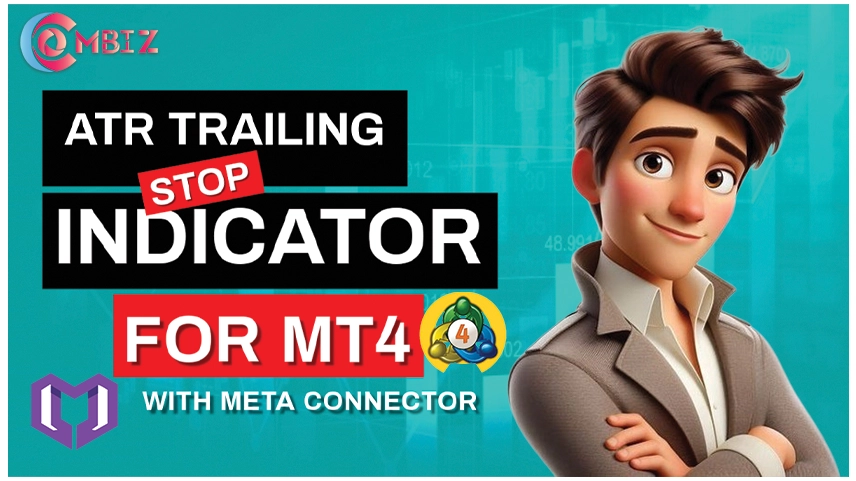
When it comes to the risk management method of locking profits, the ATR trailing stop is perhaps the most well-known technique. The stop moves with the price action itself, which allows it to dynamically adjust the stop level during increased market volatility, and vice versa. This article discusses all about an ATR trailing stop—the definition, method of working, and why you should consider employing it in your trading strategy.
What Is the ATR Trailing Stop?
Think of the ATR trailing stop as a stop-loss order that moves with the price, adjusting according to what is happening to market volatility. It uses the Average True Range (ATR) indicator, which measures how much an asset or currency pair typically moves during one period. When volatility crosses above the usual, the ATR trailing stop widens to account for these larger price swings, while in times of low volatility, it shrinks so as not to realize premature stop-outs.
While a fixed stop-loss remains stationary no matter what the price is doing, the ATR stop "trails" the price as it moves in the trader's favor. In such a manner, traders can remain in profitable positions longer, while the stop level simultaneously moves closer to the price, either due to lower volatility or because the price has started moving against the trader.
How Does the ATR Indicator Work?
Understanding Average True Range (ATR)
The Average True Range (ATR) serves as a volatility indicator, quantifying price movement range over a set duration. Primarily computed across 14 periods, it aids traders in gauging market volatility levels.
Calculation of ATR
To calculate ATR, analyze the true range, determined as the highest value among the following three:
- Distance between the current day's high and low.
- The distance from yesterday’s close to today’s high.
- The distance from yesterday’s close to today’s low.
Contact Us for Inquiries
By analyzing these values, the ATR shows the volatility of an asset, and this value can be averaged over a set period to display the typical price movement.
How the ATR Trailing Stop Works
The ATR trailing stop method utilizes the Average True Range (ATR) to adapt the stop level as the price progresses in your favor. Below is an example of how this strategy can be executed properly:
ATR Stop Placement
- For example, if you were to first calculate an ATR value and then multiply it by some factor (1.5 or 2), you would be setting the distance for the trailing stop from the entry point.
Action: price trail
- The trailing stop automatically moves with the price as long as the price moves in our favor and brings it closer to the ATR value.
Leverage Dynamic Stops to Lock in Profits
- If the price reverses or widens, the stops adjust themselves to reflect the price movement, locking profits and mitigating risk.
Advantages of Using an ATR Trailing Stop
1. Dynamic Risk Management
The ATR trailing stop reads the volatility of the market and adjusts its position so that it could protect your yourtops from being hit too early in very volatile moments. Thus you are free to stay in trades longer and can better weather the volatile markets.
2. Locking in Profits While Cutting Losses
Since a trailing stop moves with price, it assists in locking profits and lessening the possibility of gains being eroded should prices reverse. This way, traders stand to reap much more profit compared to fixed stop-loss systems.
3. Disciplines the Strategy
Making the stop-losses automated by utilization of the ATR indicator keeps the trader from the emotional route of decision-making when stops are manually set. Hence, automating this bit of trading will help keep the trader's attention on the strategy rather than distractions from market waves.
Automate ATR Trailing Stops Using MetaConnector
MetaConnector is a very effective piece of software that has the ability to provide real-time automation of the ATR trailing stop strategy. As your TradingView signals pass through MetaConnector linked with MetaTrader (MT4 or MT5), this tool automatically executes ATR-based stop-loss orders with speed and accuracy, ensuring prompt and precise trades.
This is what makes the MetaConnector approach a better option for your ATR trailing stop:
Advantages of Using MetaConnector with ATR Trailing Stops
1. Automated Execution
- MetaConnector automatically places your ATR trailing stop order whenever conditions apply, so there is no delay, thereby providing better precision. Now, with real-time executions, you can rest assured that your stop-loss levels are promptly adjusted according to the ATR values.
2. Dynamic Adaptation to Volatility
- By automating the ATR trailing stop, MetaConnector helps you adjust for changes in volatility in real time so you might pocket more profits while protecting your trades from sudden reversals.
3. Consistent, Emotion-Free Trades
- By automating the ATR trailing stop process, trading becomes devoid of human emotion. This ensures that you stay disciplined and adhere to your strategy even when volatile conditions tempt otherwise.
Check out the pricing details
Conclusion
The ATR trailing stop is truly dynamic; it aids traders in the management of risk and securing profits by being in accordance with market volatility. Compared to traditional fixed stop-loss schemes, it affords a great deal of flexibility by allowing the trader to stay longer in profitable trades.
Using MetaConnector along with your trading strategies will allow you to automate all of your ATR trailing stop orders to your trading strategy, ensuring that every trade is executed exactly as planned. With MetaConnector, your trading becomes smoother, performs better, and inspires confidence.